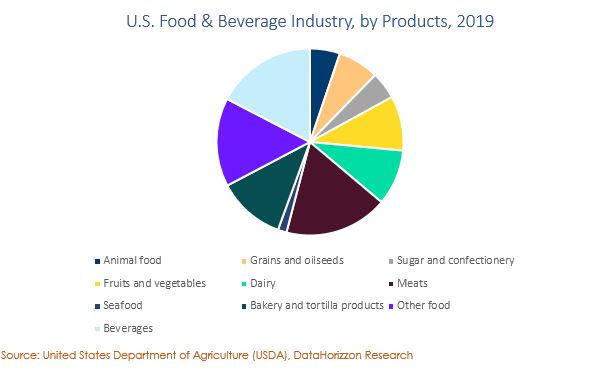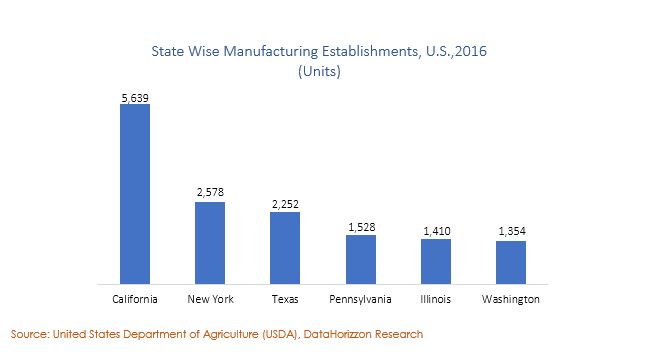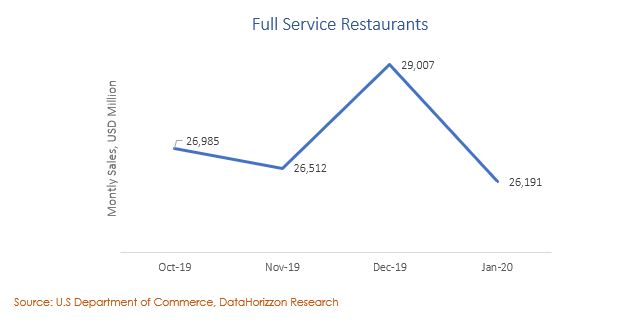The outbreak of COVID-19 has significantly impacted the food and beverage industry in the U.S. owing to the serious government regulations imposed by the U.S. government. Social distancing guidelines and lock down of the states within the country is hampering the revenue generation of the food & beverages companies. Moreover, as number of restaurants, and retail stores are closed, the industry is witnessing a considerable downfall in the present scenario.
Furthermore, the consumption and behavior pattern of the consumers in the country is rapidly changing. In 2019, the out-of-home consumption spending i.e. on full-service restaurants, limited service restaurants, recreational places, among others accounted for more than 55% of the total food & beverages market. However, the current Covid-19 pandemic has resulted in growing revenues of food-at-home consumption.

Although the key players are focusing on the distribution and production of the products to the end-consumers, suppliers are finding it difficult to cope with the supply chain disruptions caused due to COVID-19 epidemic. Another major problem is sudden shift of demand form restaurants to grocery store, is creating severe logistics challenges, as suppliers are finding it difficult to make the transition from wholesale packaging for restaurants to retail packaging of products for grocery stores.
The major food and beverages products contributing to the major share in the market includes, meat, dairy, fruits & vegetables, bakery & tortilla products among others. Meat accounted for a major market share in the food and beverage industry exceeding 20 percent of the total market. Taking into account the current COVID-19 impact, the production and sales of the food & beverage products has significantly changed. However, in the current scenario products such as dairy and bakery & tortilla products are in huge demand from the end-consumers.

The major states contributing to the growth of food & beverage industry in the U.S., includes California, Pennsylvania, New York, Texas, and Illinois among others. The presence of the major food & beverages producers coupled with multiple processing plants operating in the aforementioned states are key factors supporting the market growth in the U.S. However, the rising number of Covid-19 cases in these states is hampering the production of food & beverages products owing to scarcity of raw materials due to supply chain disruptions. Thus, the production facilities in these states are witnessing downfall in their production volume thereby resulting in drastic revenue fall in the first quarter of 2020. Moreover, as the number of cases in the U.S. are increasing, it is estimated that out-of-home consumption revenues will drastically fall in the second quarter which will impact the overall food and beverage industry in the U.S.

The companies operating in the food & beverage industry in the U.S. are facing revenue falls owing to supply chain disruptions and reduced consumption. The overall growth of the market is currently witnessing a downward trend in the current scenario, however at-home consumption has increased, but the major contributor to the revenue was form out-of-home consumption. The out-of-home consumption which generated highest revenue margins has nearly come to a standstill condition. Moreover, sales of full-service restaurants have considerably decreased as compared to the fourth quarter of 2019. It is estimated that the first and second quarter of 2020 will witness a severe down fall for the restaurant industry. Thus, the current covid-19 pandemic will affect the food & beverage industry in a long-term run, where the companies operating in the country has to focus on certain aspects such as distribution networks, sourcing strategies, and product pricing. Furthermore, this situation will affect the customer buying behavior and product demand in the coming period.

